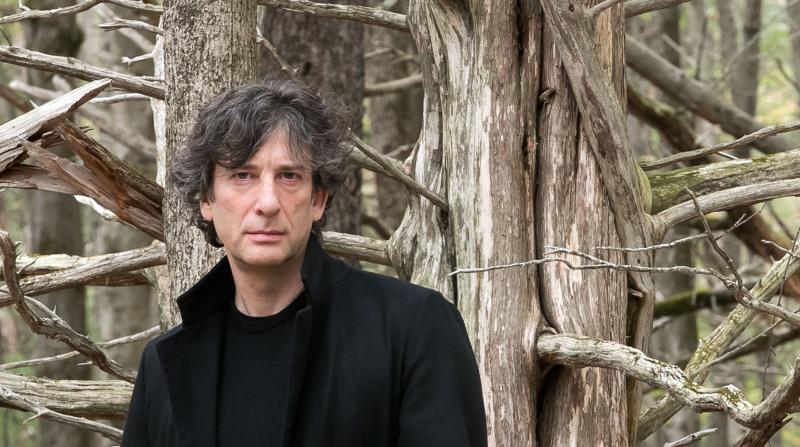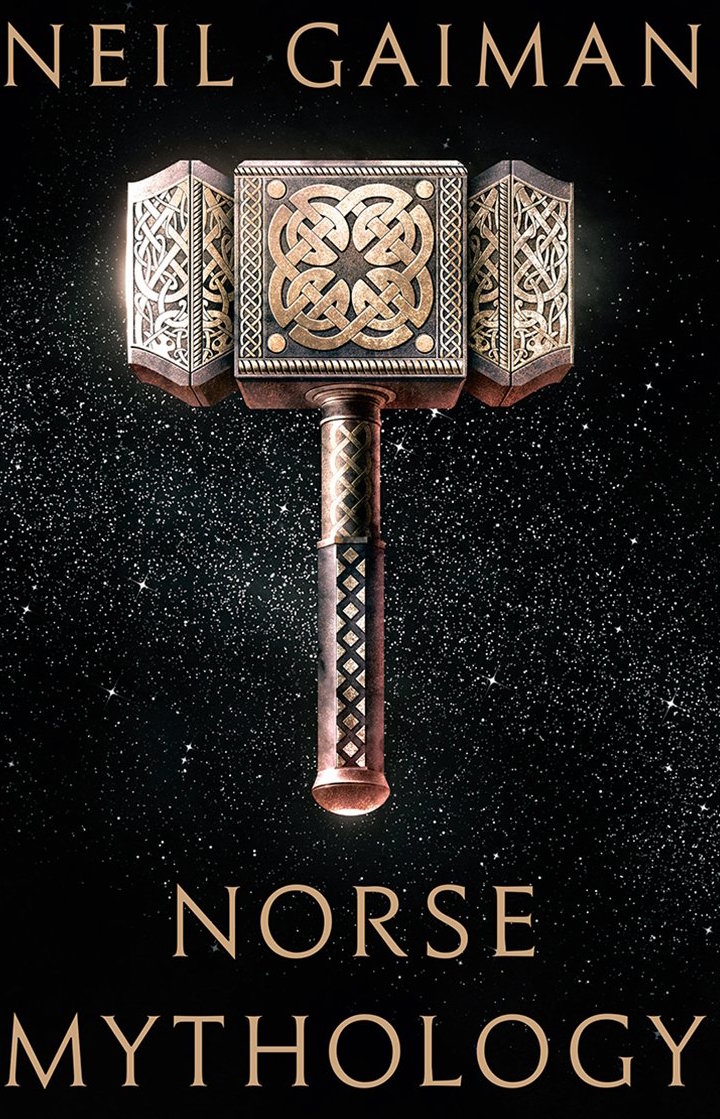Sunday Book: Neil Gaiman - Norse Mythology | reviews, news & interviews
Sunday Book: Neil Gaiman - Norse Mythology
Sunday Book: Neil Gaiman - Norse Mythology
Sly and droll re-tellings of legends from the north

Odin the All-Father, “lord of the slain, the gallows god”, has two ravens that “perch on his shoulders and whisper into his ears” as he wanders in disguise around the world. They are Huginn and Muninn, Thought and Memory. Over many centuries, the folk-stories of the northlands have lodged in our memory and shaped our thought.
When a single body of legend broods over a vast range of cultural expression all the way from the opera house (in Wagner’s Ring) to cult TV series and Marvel Comics – Neil Gaiman’s first exposure to the Norse pantheon – it gives each new re-interpreter both a bonus and a burden. The bonus comes first from a widespread vague familiarity with these tales of gods and monsters, of giants and elves, of trickery and treachery: “myths of a chilly place” in the shadow of a final catastrophe that will fulfil the destiny of the nine worlds “in ash and flood, in darkness and in ice”. Even people who have never read or viewed the work of a Martin or a Tolkien (that other great plunderer of the north) count their weekdays according to the names of the divine dwellers in Asgard: Tyr, Odin, Thor and Frigg. Besides, like one of those bottomless cauldrons full of magic ale that Odin and his immortal clan drain, this source never dries. “That’s the joy of myths,” writes Gaiman in his preface to his artful and enjoyable selection from the ancient yarns. “The fun comes in telling them yourself.”
As for the burden, familiarity can breed, if not contempt, then impatience. What can you bring to the feast that will surpass the feats of writers from Thomas Gray, who penned his “Norse odes” in the 18th century, and William Morris, who translated and re-imagined the Icelandic Eddas in the 19th, to modern tale-spinners such as AS Byatt, author in 2011 of the memorable Ragnarok: the End of the Gods? Gaiman reminds us that the world of Asgard is intensely competitive, with the gods and their rivals – mighty giants, clever dwarfs, enigmatic elves – striving to outdo one another in contests of skill and strength. Most of his 15 stories, which run from the pre-creation “void” made up of mist and fire to the “final battle” of Ragnarok, with its promise of rebirth after armageddon, turn on ordeals and challenges. In order to retrieve his stolen weapon, for example, muscle-bound, hammer-swinging Thor has to don fairly unconvincing drag, pretend to be the beauteous, golden-tressed Freya, and set off to marry Thrym, “lord of all the ogres”. The wedding banquet does not go well, as Thor conspicuously fails to get in touch with his feminine side.
In taking on the mantle of these archetypal tales, the author of the Sandman graphic novels, of Coraline, American Gods and The Graveyard Book has set himself just such a public challenge. How does he fare? The boy doesn’t do too badly at all – as the laconic divinities of Aesir might, grudgingly, admit. In contrast to the Morris and Tolkien tradition, he avoids neo-medieval splendour and sentiment in favour of a swift, terse and often ironic narrative voice - much closer, arguably, to the Icelandic austerity of Snorri Sturluson’s 13th-century Prose Edda.
archetypal tales, the author of the Sandman graphic novels, of Coraline, American Gods and The Graveyard Book has set himself just such a public challenge. How does he fare? The boy doesn’t do too badly at all – as the laconic divinities of Aesir might, grudgingly, admit. In contrast to the Morris and Tolkien tradition, he avoids neo-medieval splendour and sentiment in favour of a swift, terse and often ironic narrative voice - much closer, arguably, to the Icelandic austerity of Snorri Sturluson’s 13th-century Prose Edda.
Gaiman writes that he chose not to revisit other modern versions – Kevin Crossley-Holland’s more lavish and lyrical Penguin Book of Norse Myths, for instance – but dived into the earliest, medieval streams of these stories. He selects frugally (fewer than half of Crossley-Holland’s 32 myths), writes sparely, and seldom overdoses on the “mead of poetry”: an art, we learn, snatched from the dwarfs and giants only “with dishonour and deceit, with murder and trickery”. Above all, he channels the wiliness and wit of Loki, the “crafty troublemaker” among the gods, rather than aiming for a high-volume macho epic style of the sort that Thor might appreciate.
Via deadpan dialogue, bathos and repartee, the story-telling cuts gods down to size: a frequent enough event, as monsters and disasters often get the better of them. “How’s Freya?” Thrym the ogre-king asks Loki. “‘Is she as beautiful as they say?’ ‘If you like that sort of thing,’ said Loki. ‘Oh, I do,’ said the ogre. ‘I do.’” When it occasionally misfires, his comic deflations can lend the stories an air of sitcom or even pantomime. After his wife pleads with the giant-king Hymir to be nice to Thor, Hymir roars that “I am grim of mind and wrathful of spirit and have no desire to be nice to anyone.” Sometimes we’re not so far from the smart-ass, adult-tickling one-liners strewn through new-wave Disney animations.
Gaiman can, and does, raise his rhetorical game when the material demands. Loki's accursed daughter Hel, for example, rules over the ignoble underworld that still bears her name among us with “skin that was blotched and striated, swollen in the bruises of death, her sightless eye rotted and pale, her lipless mouth wizened and stretched over skull-brown teeth”. Premonitions of Ragnarok, meanwhile, drive Gaiman's prose to heights of dread as his story-teller foresees the eclipse of humanity and divinity alike in “the age of cruel winds, the age of people who become as wolves”. Throughout the 20th century, the apocalyptic last battle envisaged in the tales of the northmen stirred the imagination of writers and artists who had endured their own era of total war. At this moment in the 21st, Ragnarok can sometimes feel as imminent as ever. Gaiman makes a spine-tingling contemporary guide to the “end times” and the twilight of the gods.
- Norse Mythology by Neil Gaiman (Bloomsbury, £20)
- More book reviews on theartsdesk
The future of Arts Journalism
You can stop theartsdesk.com closing!
We urgently need financing to survive. Our fundraising drive has thus far raised £49,000 but we need to reach £100,000 or we will be forced to close. Please contribute here: https://gofund.me/c3f6033d
And if you can forward this information to anyone who might assist, we’d be grateful.

Subscribe to theartsdesk.com
Thank you for continuing to read our work on theartsdesk.com. For unlimited access to every article in its entirety, including our archive of more than 15,000 pieces, we're asking for £5 per month or £40 per year. We feel it's a very good deal, and hope you do too.
To take a subscription now simply click here.
And if you're looking for that extra gift for a friend or family member, why not treat them to a theartsdesk.com gift subscription?
more Books
 'We are bowled over!' Thank you for your messages of love and support
Much-appreciated words of commendation from readers and the cultural community
'We are bowled over!' Thank you for your messages of love and support
Much-appreciated words of commendation from readers and the cultural community
 Frances Wilson: Electric Spark - The Enigma of Muriel Spark review - the matter of fact
Frances Wilson employs her full artistic power to keep pace with Spark’s fantastic and fugitive life
Frances Wilson: Electric Spark - The Enigma of Muriel Spark review - the matter of fact
Frances Wilson employs her full artistic power to keep pace with Spark’s fantastic and fugitive life
 Elizabeth Alker: Everything We Do is Music review - Prokofiev goes pop
A compelling journey into a surprising musical kinship
Elizabeth Alker: Everything We Do is Music review - Prokofiev goes pop
A compelling journey into a surprising musical kinship
 Natalia Ginzburg: The City and the House review - a dying art
Dick Davis renders this analogue love-letter in polyphonic English
Natalia Ginzburg: The City and the House review - a dying art
Dick Davis renders this analogue love-letter in polyphonic English
 Tom Raworth: Cancer review - truthfulness
A 'lost' book reconfirms Raworth’s legacy as one of the great lyric poets
Tom Raworth: Cancer review - truthfulness
A 'lost' book reconfirms Raworth’s legacy as one of the great lyric poets
 Ian Leslie: John and Paul - A Love Story in Songs review - help!
Ian Leslie loses himself in amateur psychology, and fatally misreads The Beatles
Ian Leslie: John and Paul - A Love Story in Songs review - help!
Ian Leslie loses himself in amateur psychology, and fatally misreads The Beatles
 Samuel Arbesman: The Magic of Code review - the spark ages
A wide-eyed take on our digital world can’t quite dispel the dangers
Samuel Arbesman: The Magic of Code review - the spark ages
A wide-eyed take on our digital world can’t quite dispel the dangers
 Zsuzsanna Gahse: Mountainish review - seeking refuge
Notes on danger and dialogue in the shadow of the Swiss Alps
Zsuzsanna Gahse: Mountainish review - seeking refuge
Notes on danger and dialogue in the shadow of the Swiss Alps
 Patrick McGilligan: Woody Allen - A Travesty of a Mockery of a Sham review - New York stories
Fair-minded Woody Allen biography covers all bases
Patrick McGilligan: Woody Allen - A Travesty of a Mockery of a Sham review - New York stories
Fair-minded Woody Allen biography covers all bases
 Howard Amos: Russia Starts Here review - East meets West, via the Pskov region
A journalist looks beyond borders in this searching account of the Russian mind
Howard Amos: Russia Starts Here review - East meets West, via the Pskov region
A journalist looks beyond borders in this searching account of the Russian mind
 Henry Gee: The Decline and Fall of the Human Empire - Why Our Species is on the Edge of Extinction review - survival instincts
A science writer looks to the stars for a way to dodge our impending doom
Henry Gee: The Decline and Fall of the Human Empire - Why Our Species is on the Edge of Extinction review - survival instincts
A science writer looks to the stars for a way to dodge our impending doom
 Jonathan Buckley: One Boat review - a shore thing
Buckley’s 13th novel is a powerful reflection on intimacy and grief
Jonathan Buckley: One Boat review - a shore thing
Buckley’s 13th novel is a powerful reflection on intimacy and grief

Add comment